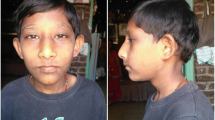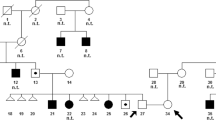Abstract
Marker chromosomes are structurally abnormal chromosomes that may be supernumerary in karyotype or replace one of the chromosomes. Marker chromosomes very frequently can be a cause of different pathologies, including a intellectual disability. This study considers the molecular cytogenetic analysis of an acrocentric marker chromosome in a patient with autism and a intellectual disability. With the help of the painting probe localization of human chromosomes, its origin from the pericentromeric regions of the p and q arms of chromosome 15 is shown. For more detailed detection of the region of origin of this chromosome, its microdissection following localization on both healthy control and patient metaphase plates was carried out. Its origin from the nucleolus-containing chromosome 15 is confirmed. Because of the rDNA-containing plasmid localization, two of the ribosome RNA gene clusters were detected on the patient’s chromosomes. Ag-NOR staining showed that both clusters are active. A possible contribution of the revealed chromosome pathology in clinical picture formation is discussed.



Similar content being viewed by others
REFERENCES
Liehr, T., Cirkovic, S., Lalic, T., Guc-Scekic, M., de Almeida, C., Weimer, J., et al., Complex small supernumerary marker chromosomes–an update, Mol. Cytogenet., 2013, vol. 6, p. 46. https://orcid.org/10.1186/ 1755-8166-6-46.
Jafari-Ghahfarokhi, H., Moradi-Chaleshtori, M., Liehr, T., Hashemzadeh-Chaleshtori, M., Teimori, H., and Ghasemi-Dehkordi, P., Small supernumerary marker chromosomes and their correlation with specific syndromes, Adv. Biomed. Res., 2015, vol. 4, p. 140. https://orcid.org/10.4103/2277-9175.161542.
Grafodatskii, A.S. and Radzhabli, S.I., Khromosomy sel’skokhozyaistvennykh i laboratornykh mlekopitayushchikh (Chromosomes of Farming and Laboratory Mammals), Novosibirsk: Nauka, 1988.
Fluorescence in Situ Hybridization (FISH)—Application Guide, Liehr, T., Ed., Berlin, Heidelberg: Springer, 2017.
Maden, B.E.H., Dent, C.L., Farrell, T.E., Garde, J., McCallum, F.S., and Wakeman, J.A., Clones of human ribosomal DNA containing the complete 18 S-rRNA and 28 S-rRNA genes, Biochem. J., 1987, vol. 246, pp. 519–527.
Bundey, S., Hardy, C., Vickers, S., Kilpatrick, M.W., and Corbett, J.A., Duplication of the 15q11-13 region in a patient with autism, epilepsy and ataxia, Dev. Med. Child Neurol., 1994, vol. 36, pp. 736–742.
Yang, J., Yang, Y., Huang, Y., Hu, Y., Chen, X., Sun, H., et al., A study of two Chinese patients with tetrasomy and pentasomy 15q11q13 including Prader–Willi/Angelman syndrome critical region present with developmental delays and mental impairment, BMC Med. Genet., 2013, vol. 14, p. 9. https://orcid.org/10.1186/1471-2350-14-9.
Battaglia, A., The inv dup (15) or idic (15) syndrome (Tetrasomy 15q), Orphanet J. Rare Dis., 2008, vol. 3, p. 30. https://orcid.org/10.1186/1750-1172-3-30.
Dittrich, B., Buiting, K., Korn, B., Rickard, S., Buxton, J., Saitoh, S., et al., Imprint swithing on human chromosome 15 may involve alternative transcripts of the SNRPN gene, Nat. Genet., 1996, vol. 14, no. 2, pp. 163–170.
Slomnicky, L.P., Pietrzak, M., Vashishta, A., Jones, J., Lynch, N., Elliot, S., et al., Requirement of neuronal ribosome synthesis for growth and maintenance of the dendritic tree, J. Biol. Chem., 2016, vol. 291, no. 11, pp. 5721–5739.
Parlato, R., Kreiner, G., Erdmann, G., Rieker, C., Stotz, S., Savenkova, E., et al., Activation of an endogenous suicide response after perturbation of rRNA synthesis leads to neurodegeneration in mice, J. Neurosci., 2008, vol. 28, no. 48, pp. 12 759–12 764.
ACKNOWLEDGMENTS
The authors thank M. Ferguson-Smith (Cambridge University, Great Britain) for providing the human chromosome libraries.
The study is supported by the Russian Science Foundation, project no. 15-15-10001.
Author information
Authors and Affiliations
Corresponding author
Ethics declarations
The authors declare that they have no conflict of interest.
Additional information
Translated by A. Khaitin
About this article
Cite this article
Telepova, A.S., Romanenko, S.A., Lemskaya, N.A. et al. The rRNA Gene Containing Marker Chromosome Associated with a Intellectual Disability: A Clinical Case Report. Mol. Genet. Microbiol. Virol. 33, 241–244 (2018). https://doi.org/10.3103/S0891416818040080
Received:
Revised:
Accepted:
Published:
Issue Date:
DOI: https://doi.org/10.3103/S0891416818040080




